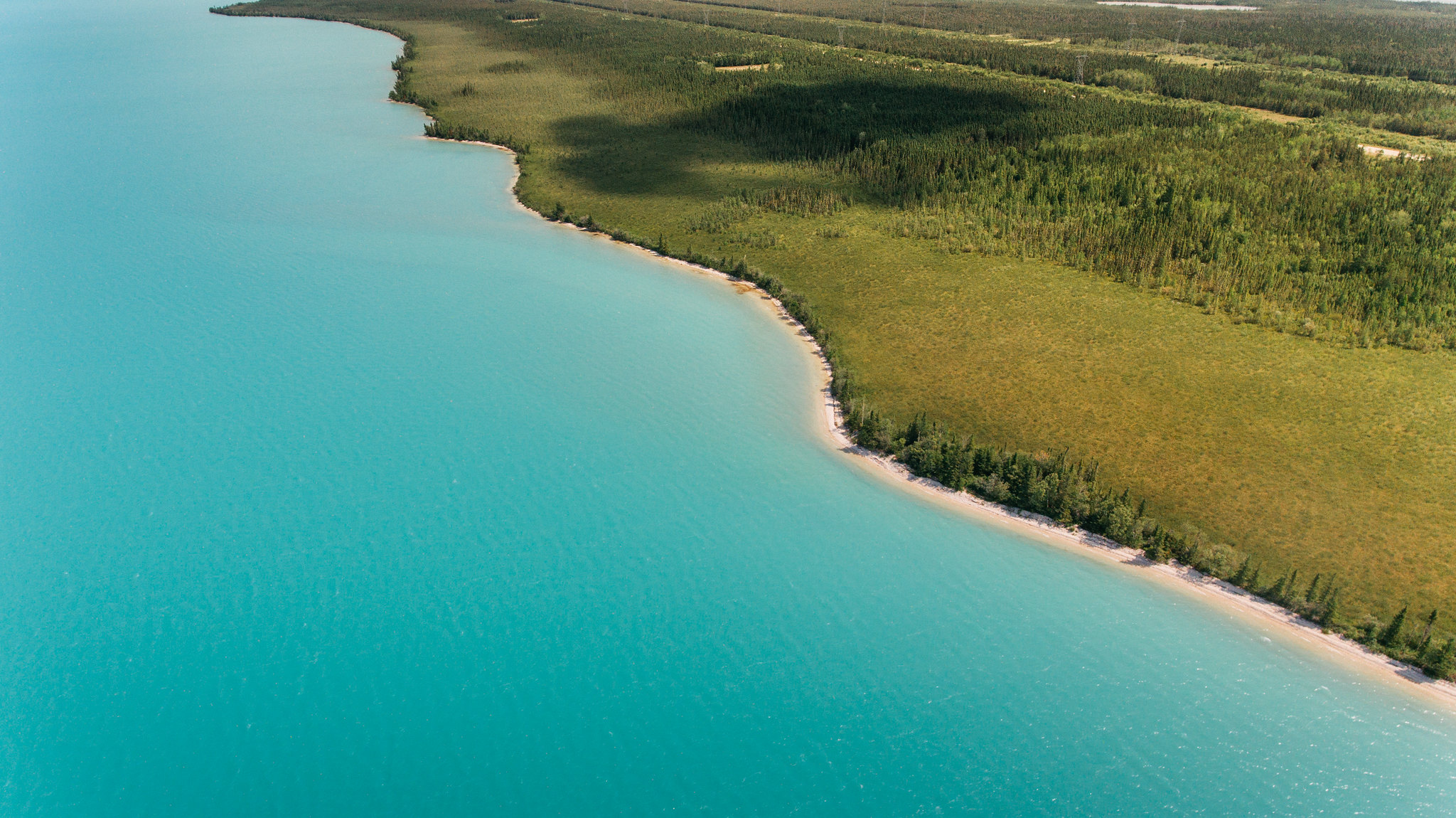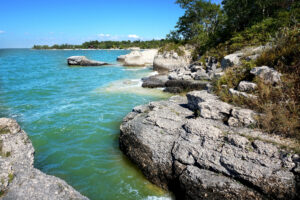Explore the unique natural beauty that is Manitoba.
The tundra landscape of Churchill, the sand dunes of Spruce woods, the snakes at Narcisse, the crystal clear waters of Clearwater Lake, the vast natural beauty of Riding Mountain, not to mention the undisturbed wilderness of Atikaki — these are just some of the well known natural attractions in Manitoba.
Listed here are 20+ must-visit natural attractions in Manitoba.
1. Clearwater Lake
Located in Clearwater Lake Provincial Park, Clearwater Lake is aptly named. The lake is so sparklingly clear that you can see all the way to the bottom, even 35 feet below the surface. The lake is known to boast some excellent fishing opportunities and is perfect for boating and swimming. At just under 600 square kilometres, the park is beautiful to explore and offers a whole host of things to do, including hiking and camping.
Clearwater Lake Caves
Clearwater Lake Provincial Park is home to a pretty special natural phenomenon. The Clearwater Lake Caves aren’t really caves at all. They are deep crevices in the earth which were formed as a result of the massive rocks splitting and breaking away from the cliffs at the lake’s shoreline. You can find these cliffs by following the self-guided hiking trail in the park. It is advised that people stick to the trail and the viewing platforms only for safety reasons and to protect the area’s ecology. Clearwater Lake and the rest of the park, which is just under 600 square kilometres in size and is mostly forested, is a beautiful place to adventure and stay.
Clearwater Lake Provincial Park is located about six and a half hours northwest of Winnipeg and is just under 30km north of The Pas.
Details
2. Riding Mountain National Park
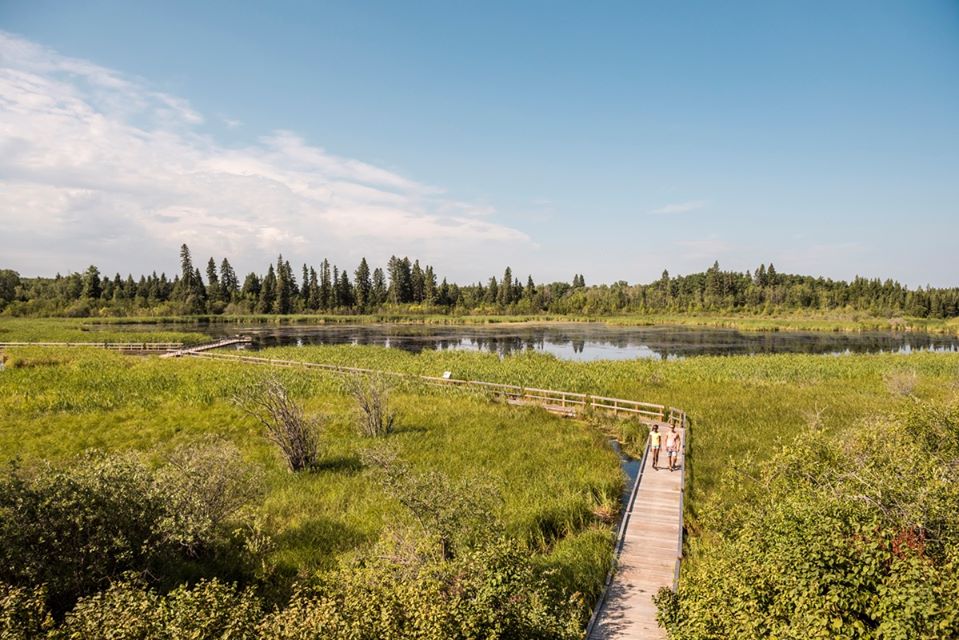
Credit: Parks Canada
The entire Riding Mountain National Park area is a marvel of nature. This incredible area is vast, at just under 3000 square kilometres.
The terrain is diverse and ever-changing. The park includes areas of grasslands, wetlands, and forests, as well as beautiful lakes, and is home to many different species of wildlife, birds, and different kinds of plants. There is even a herd of plains buffalo that call an enclosed area home near Lake Audy. The park boasts excellent camping, as well as spectacular hiking and biking trails.
Riding Mountain National Park is located around 100km north of Brandon and three hours northwest of Winnipeg.
3. Spruce Woods Provincial Park
Located in the Spruce Woods Provincial Park, the Spirit Sands (or Carberry Sandhills) are four square kilometres in size, and are the only dunes in the entire province. The dunes were once a delta on the Assiniboine River. The Spirit Sands see enough rain that many plants live and thrive in the area.
While the Spruce Woods Provincial Park is home to the only dunes in Manitoba, it is also the home of another fantastic natural feature, the Devil’s Punch Bowl. The area is connected to the Spirit Sands area by a 2km trail.
The Devil’s Punch Bowl is formed by an underground stream and is almost 150 feet deep. The bowl is pretty cool, as it was created by sand being eroded by the underground water and collapsing to form the bowl-like shape.
The water is a remarkable green-blue colour due to the silt in the water. It is a hotspot for many birds and a great place to bird-watch.
Spruce Woods Provincial Park is approximately two hours west of Winnipeg, just under an hour southeast of Brandon.
4. Grass River Provincial Park
The Grass River Provincial Park lies in the northwest corner of the province.
If you’re looking for a bit of pristine, unspoiled wilderness, the entire park is a natural haven perfect for exploring on land or by the water.
Experience the rugged Precambrian Shield, the wild Grass River, and many different sparkling lakes. The area is home to caribou, moose, wolves, bear, and wolverine. There are several campgrounds in the park, so you can extend and make the most of your adventure.
Details
Wekusko Falls
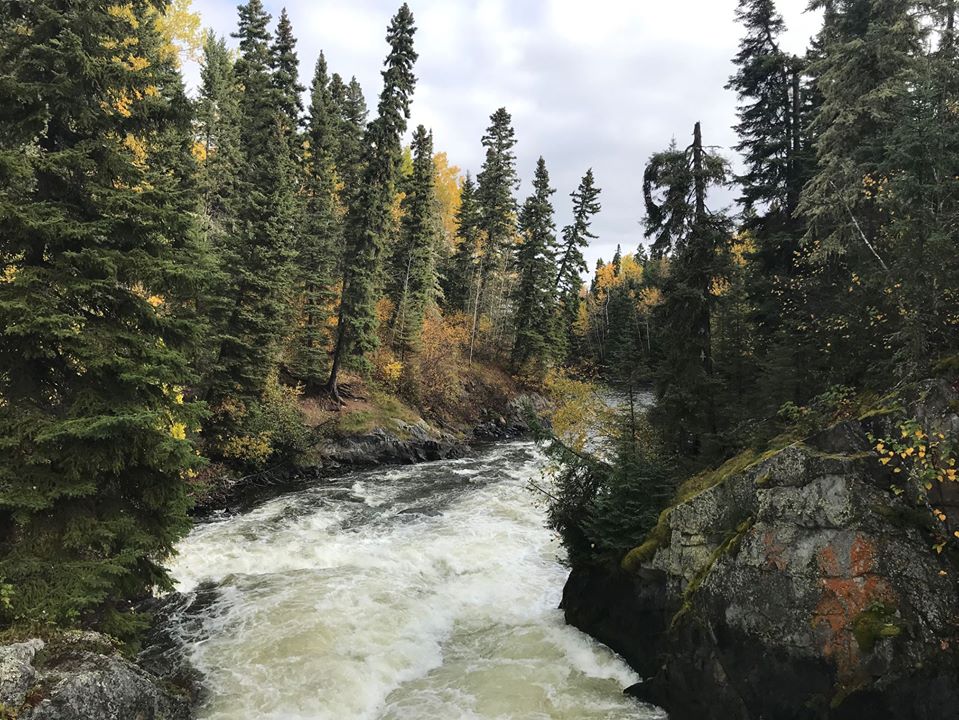
Credit: Manitoba Parks
The beautiful Wekusko Falls are located on the Grass River and are created by a 12-meter (nearly 40 feet) drop over a stretch of rapids. Two suspension bridges span the falls for viewing in two different locations. The falls are located in Wekusko Falls Provincial Park. Camp out in the park or book a stay at the lodge.
Karst Spring
Karst Spring is located in the Grass River Provincial Park. A great way to see Karst Spring is to follow the Karst Spring Trail. The trail is a 3.4km loop that is moderate in difficulty. It meanders past the Grass River through a forested area. The spring is located about halfway through the trail. The spring is a bit of a mystery since it seems to flow right out of solid rock. The spring is at a juncture where the Precambrian Shield and sedimentary rock meet up. One possible cause of the spring is that the water can seep around the sedimentary rocks, but when it meets the Precambrian Shield, it can’t seep into the solid rock and instead has to come gushing out at that point. The head of the Karst Spring Trail is located in the Iskwasum Campground.
The Grass River Provincial Park is 586km northwest of Winnipeg and 117km northeast of The Pas.
5. Pisew Falls
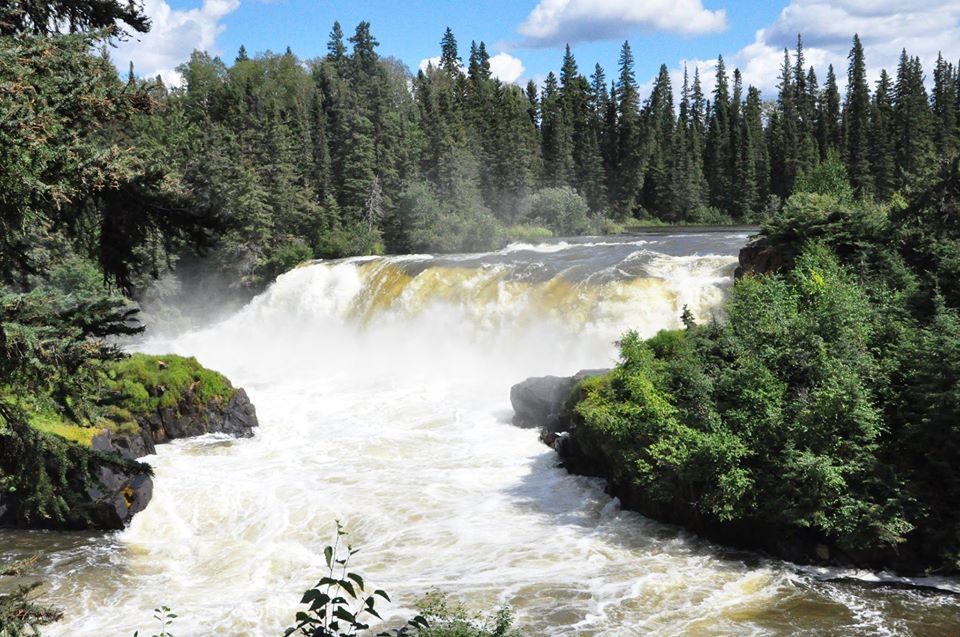
Credit: Manitoba Parks
One of the best-known waterfalls in Manitoba has to be Pisew Falls. These falls are located in Pisew Falls Provincial Park and are created as the Grass River drops almost 43 feet. The river changes direction to run down a gorge. There are trails throughout the area that lead to several different observation platforms and to a bridge that spans the Grass River. This bridge leads to a 22km long (return trip) trail that leads to the Kwasitchewan Falls, also located in the park. This breathtaking waterfall is the province’s tallest waterfall. With backcountry campsites located at the far end of the looped trail, why not camp out and see both of these amazing falls?
Pisew Falls is located 315km northeast of The Pas, forty-five minutes southwest of Thompson and nearly seven hours northwest of Winnipeg.
6. Steep Rock
Beautiful waters, rocky cliffs, small caves, beautiful sunset – all these await you at Steep Rock. The area has limestone cliffs and fresh water. There are several kinds of fish that you won’t find anywhere else. Spend time swimming and rent a kayak or canoe to explore the area further. Walk along the shoreline of the cliffs, kayak or explore the caves, or enjoy turquoise waters from the quarry. There is so much to do here. Those who enjoy hiking can try the hiking trail that encircles the quarry.
7. Nopiming Provincial Park
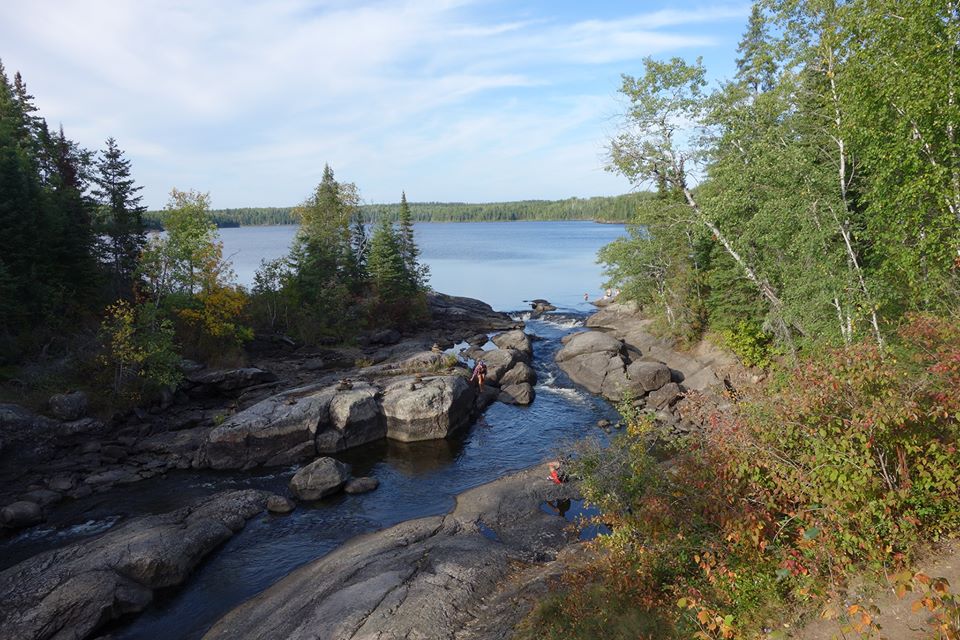
Credit: Manitoba Parks
The Nopiming Provincial Park lies in the southeast corner of Manitoba. For those that think you have to travel north to get into the unspoiled, rugged wilderness, think again! Nopiming is just over 1400 square kilometres and is a vast wonderland for those seeking backcountry-style adventures. The park features granite shields, dense forested areas, and hundreds of sparkling, clear lakes.
There are four campgrounds in the park and also three lodges, so there is no shortage of places to stay. Plan your next getaway to this incredible area.
While you’re there, keep your eyes peeled for abandoned mine shafts and equipment- it’s not a natural wonder, but it is pretty cool!
Nopiming Provincial Park is located three and a half northeast of Winnipeg.
Details
8. Grand Beach
Located in the Grand Beach Provincial Park on Lake Winnipeg’s eastern shore is the amazing Grand Beach. This beach, which features white sand and, in the distance, grassy dunes that tower up to thirty feet high, has been touted as one of the top beaches in the entire country. The park features some great hiking and walking trails and a campground as well, so you can come to enjoy the beach for more than a single afternoon.
Grand Beach Provincial Park is located 100km northeast of Winnipeg and 65km northeast of Selkirk.
Details
9. Atikaki Provincial Wilderness Park
If you’re an avid outdoor enthusiast, Atikaki Provincial Wilderness Park is a must. There is no road access to this vast, wild wonderland, but that’s the attraction! The most common used route by water begins in Wallace Lake. The park’s webpage calls the area “one of the most magnificent examples of shield country anywhere.” There are no designated campgrounds, but there are sites with old fire rings along the route. If you’re not confident in exploring by yourself, there are lodges and outposts that you can book as well.
Wallace Lake is 260km northeast of Winnipeg.
Details
10. Brokenhead Wetland
The Brokenhead Wetland Interpretive Trail is 2.7km long, round-trip, trail that runs through an amazing area known as the Brokenhead Wetland. There are many rare plants and wildflowers that grow in the wetland area. While the area is beautiful and the ecology unique, the area is also historically and culturally significant. The Ojibway people have used the Brokenhead Wetland area for over 300 years and they consider it a sacred area.
The wetland is located just under an hour northeast of Winnipeg and thirty minutes northeast of Selkirk.
Details
11. Tramping Lake Pictographs
Tramping Lake is a beautiful lake in Northern Manitoba. It is a great lake for fishing and features rocky islands, densely forested areas, and sparkling waters.
The lake is also well known for the Tramping Lake Pictographs. These pictographs, also known as rock paintings, were painted by Indigenous people, though the date they were painted has been debated. The paintings depict tools, animals, and more.
Tramping Lake can also be reached by the Grass River. If you’re uncertain about finding the paintings yourself, try staying with a lodge or booking with a guide who knows the area.
Tramping Lake is located 569km northwest of Winnipeg and 112km east of Flin Flon.
Details
12. Narcisse Snake Dens
The snakes come back to their dens in the fall months and can be viewed on warm days.
The snake dens are located 110km northwest of Winnipeg, and 6km north of Narcisse.
13. Whiteshell Provincial Park
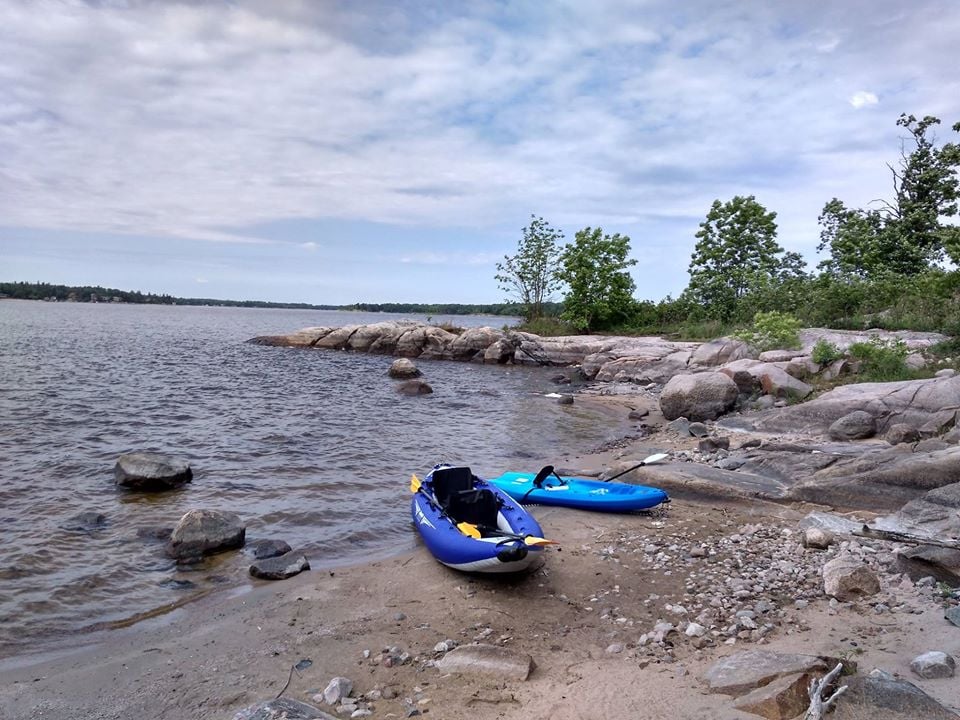
Credit: Manitoba Parks
If you’re a wilderness lover and a hiking enthusiast, you should consider a trip to the Whiteshell Provincial Park. At 2800 square kilometres, the park is an incredible area that stuns with sparkling, pristine lakes, wetlands and marshes, forested areas, and granite outcrops that belong to the Canadian Shield. The park is like a natural playground, and it would take months, if not years to explore it all. There are a ton of different hiking trails that cross throughout the park in all different lengths, beautiful campgrounds and lodges to stay, gorgeous lakes, phenomenal beaches, and great fishing.
The park is located an hour and a half east of Winnipeg.
Details
Rainbow Falls
Located in Whiteshell Provincial Park on Falcon Lake, Rainbow Falls is a favourite stop for many people. The falls also have a wheelchair-accessible dock and can be reached by driving from the White Lake Resort Access Road. The trail that runs to the falls is 1.4km long round trip and is great for people of all ages. Whether you’re staying in the park or driving through and want to get some great photos, it’s a stop you won’t want to miss.
Details
West Hawk Lake
This incredible lake is located in the Whiteshell Provincial Park.
Part of the lake is made up of a large, deep crater, which was believed to be caused by a meteor strike. The lake is 377 feet deep at the deepest part, which makes it the deepest lake in Manitoba. The lake is surrounded by rugged granite shores and towering trees. The park boasts amazing hiking trails and a great campground, as well as several resorts.
Details
14. Cranberry Lakes
The Cranberry Lakes is a beautiful chain of three different, interconnected lakes. First Cranberry Lake offers boat access to Second and Third Cranberry Lakes.
The lakes are known as a premier sport fishing destination. It’s not uncommon to catch a trophy-sized pike, walleye, or trout. The scenery is breathtaking. The lakes are surrounded by rugged, tree-lined shorelines and are dotted with equally as rugged islands. The Second Cranberry is 150 feet deep at the deepest spot, while the other lakes are 30 and 40 feet deep. Second Cranberry is also the largest of the lakes, at approximately 11km long. There are many other lakes that can be reached from the Cranberries by portaging a canoe or kayak.
First Cranberry Lake is located seven and a half hours northwest of Winnipeg, just over an hour north of The Pas, and an hour southeast of Flin Flon.
Details
15. Little Limestone Lake
Little Limestone Lake, at 15 km long and 4 km wide, is actually one of the largest examples of a marl lake in the world. A marl lake is a body of water that is rich in calcium carbonate. The lake changes colour with the temperature, as the calcite either separates or dissolves with the temperature. The lake can appear crystal clear or it can have a more Caribbean-like tropical look. The lake is quite fascinating and is worth a visit.
Little Limestone Lake is located 500km northwest of Winnipeg.
16. Churchill
Churchill is located just over 1000km north of Winnipeg, and is just over 400km north of Thompson.
Details
17. FortWhyte Alive
FortWhyte Alive is a 640-acre urban green space in Winnipeg. In addition to providing outdoor recreational opportunities, they conduct various educational and environmental activities and cultural programming. Not only is this a great place to spend outdoors, but through its various programs, FortWhyte Alive promotes an awareness of sustainable living.
FortWhyte Alive holds many popular events throughout the event, the major ones being the outdoor winter party Lake Shaker and the summer-camp-inspired party, The Great Escape. FortWhyte Alive also conducts three ecotours that give a glimpse of the history and life in the prairies. Discover how bisons influenced the history of Manitoba and its people at FortWHyte Alive’s A Prairie Legacy: The Bison and its People, a Canadian Tourism Signature Experience. Details

Credit: FortWhyte Alive
18. International Peace Garden
Dedicated to peace is the International Peace Garden, located on the Canadian/American border near Boissevain. More than just a garden, this space is also the home of the Peace Chapel, International Peace Tower, September 11 Memorial, and the North American Game Warden Museum. Featured here is a unique working clock made entirely of flowers.
There are many trails to enjoy at the Garden. You can also go boating or have a picnic in this exquisite garden. Details
19. Oak Hammock Marsh

Credit: Oak Hammock Marsh
Located just 20 km north of Winnipeg between Stonewall and Selkirk, there are 30 km of different trails that wind through the unique ecological area.
Check out the different marshes, follow the boardwalks, or venture down grassy paths. Almost 300 different species of birds call the area home, which will delight bird watchers and nature enthusiasts of all ages. Be sure to bring your camera or binoculars.
20. Bakers Narrows Provincial Park
Just south of Flin Flon is the Bakers Narrows Provincial Park. The park is an angler’s dream, with excellent trout and walleye fishing. You can also see many wildlife and a variety of birds here.
Climb to the lookout tower to see spectacular forest views, rock outcrops, and crystal-clear waters. Those wanting to spend the night can book one of the campsites. Head to the beach to enjoy swimming, boating, or fishing.
